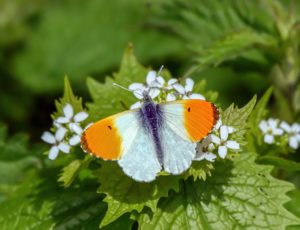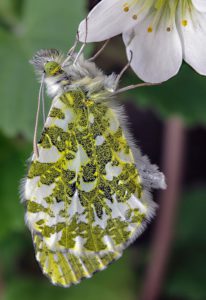Understanding the Life Cycle of the Orange-Tip Butterfly
History of the orange-tip butterfly

Anthocharis cardamines, the orang-tip butterfly is most active during the spring months and can be seen between April and July. This butterfly is in the family Pieridae with a species of some 1, 100 which is large.
The orang-tip butterfly gets its name from the bright orange tip that’s found on the forewings of the males. These butterflies love the bright sunlight and can be seen actively flying about under these conditions.
Once the male finds a female the courtship begins, after mating the female lays a single egg on the host plant along with depositing pheromone that will discourage other females from laying their eggs in the same spot. The orang-tip butterfly will cause your garden to come alive as they display their beautiful wingtip of bright orange. Below we will go more in-depth on the life cycle and other facts of this butterfly.
The natural habitat of the orang-tip butterfly
The natural habitat of the orange-tip butterfly includes hedgerows, streams, meadows, rivers, woodland glades, forest edges, grassland but rarely visits gardens.
The life cycle of the orange-tip butterfly
As was discussed the female will lay a single egg on the host plant followed by releasing a pheromone that will discourage other female orange-tip butterflies from laying eggs in the same area. The newly deposited eggs are pale but within in few days turn and orange color.
The eggs hatch in about 10 days, as the caterpillar emerges it eats the shell. The caterpillar is pale and orange. Because these caterpillars are hudge eaters if food is not available they turn on each other (cannibalism).
As the caterpillar pupates it secures itself by tail hooks in a pad of silk and a silk girdle to the plant’s stem. During this stage, the chrysalis becomes brown or pale green. The chrysalis will overwinter and when springs arrive a beautiful butterfly emerges.
Attracting the orange-tip butterfly into your garden
Although it’s said that these butterflies hardly visit gardens they are one of the first to be seen in gardens as an indication that spring is near, to entice them to hang around however you must make your garden so appealing that they can’t resist.
1. Installing nectar plants is so important, some of these plants are as follows.

- Lady’s Smock
- Common Violets
- Sweet Rocket
- Dandelions
- Daisey
- Blue Bells
- Hedge Mustard
- Cow Parsely
Installing shrubs and climbing ivy will also give them a place to shelter or overwinter during the harsh cold freezing months.
2. Placing a shallow bowl of sand mix with water will not only act as a watering hole but will provide them with the minerals they need.
3. Placing a few medium-size rocks in your garden will provide a resting place.
4. Install plants in clusters or masses.
5. Ensure that garden plants are installed in a sunny location to meet garden plant requirements also butterflies love sunlight.
6. Installing shrubs and taller trees will act as a wind-breaker to protect butterflies.
11 fun facts about the orange-tip butterfly
1. As the names say these butterflies have beautiful orange tips on their wings.
2. There are about 1,100 species which makes this group a large family.
3. These butterflies are medium size.
4. They are very beautiful and easy to recognize when their wings are open.
5. The female butterfly releases a pheromone to ward of other female butterflies from laying their eggs on the same site.
6. It’s believed that the orange-tip caterpillar will eat eggs of unhatched orang-tips.
7. Once these butterflies are spotted it’s and an indication that spring is near.
8. The orange-tip butterfly is common in Britain and Irland.
9. They might be one of the first butterflies that are spotted in gardens during springtime.
10. The orange-tip species have increased over the years which means they will be around for generations to come.
11. Only the males have the orange-tips, the females have aged grey-black tips.
Additional information
1. Don’t use harmful pesticides which will have a negative impact both on the adult and larva of the orange-tip butterfly.
2. Beneficial insects can also be harmed by pesticides.
3. Encourage beneficial insects into your garden with these proven methods. The presence of beneficial insects will feed on the bad bugs.
4. Installing a 2-3 inch layer of mulch around your garden plants has these benefits.
5. Don’t squash caterpillars because they just might be the larva of the orange-tip butterfly.
6. When watering garden plants do so from the base of the soil level because this is not only the correct way but will avoid knocking caterpillar of the leaves.
7. The use of fertilizers will keep your garden plants thriving, before applying fertilizers read and follow the manufacture’s directions.
8. Damp garden soil will also provide butterflies with the minerals they need to strengthen their reproductive system. This area of the garden where the soil is moist is known as a mud puddle.
9. Keep bird feeders and birdbaths away from the butterfly habitat.
The final word about the orange-tip butterfly
The orange-tip butterfly will grace your garden providing you give them what they are looking for. These garden beauties will bring your garden to life with their color and activity so why not consider making your garden oasis home for the orange-tip butterfly both for you and your family to enjoy during the beautiful spring and summer months.
About the author
Norman loves being in the garden, both at home and for his job....
he is 'Natures Little helper' being outdoors, growing his vegetables and flowers from an early age.
Now having spent over 22 years in the profession he want to give some of his knowledge to others...
his vast array of hints and tips you will find scattered over this site will help you no end growing plants in your garden.

A new type of butterfly that I am learning about on your website here. I am happy to see you give this information about the orange tipped butterfly. They are quite beautiful and since I am with my mum this period, I would like to try to get them to come to her garden. I will follow all the procedures you have written here to get them here. Thanks!
Constructing a butterfly garden is a great garden project that will cause your garden to come to life with much activity as you watch these garden beauties in their natural habitat. I am so happy to help and wishing you the best of success with your garden project. Have a good day.
Wow! Sucha beauty to behold and I really appreciate you for sharing this post out here. This is a shear beauty and thank you for sharing. This orange tip butterfly us definitely a beauty and having such on my farms would invariable spell for joy and beauty added to the garden and farm. This is great and will also ensure I stay clear using harmful elements on it
Having these butterflies around does bring a certain flavor to a garden setting. Providing a home for the orange-tip butterfly will also helping to bring balance to our ecosystem. So happy to help.
Hello…..i didn’t know more about Orange-tip butterfly. Its color beautifies the garden and makes the garden look lively.I never new that a caterpillar would turn on to each other due to lack of food and the fact that they are a sign of spring season. I actually love butterflies and through this article i can see there is a possibility of bringing them to my garden by providing water food and resting places.
The presence of butterflies in a garden setting is pretty amazing. These garden beauties can bring so much activity and life to a garden setting. I am so happy that I could help. Wishing you the best with your butterfly garden project.